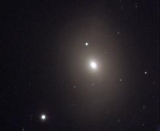
Messier 85
Encyclopedia
Messier 85 is a lenticular galaxy
(type S0) in the Coma Berenices constellation. It is 60 million light years away, making it the 94th most distant Messier object, and it estimated to be 125,000 light years across.
It was discovered by Pierre Méchain
in 1781. It is the northernmost outlier of the Virgo cluster
discovered as of 2004.
The type I supernova
, 1960R was discovered in M85 on Dec 20, 1960 and reached an apparent magnitude
of 11.7.
M85 is interacting with the nearby spiral galaxy
NGC 4394, and a small elliptical galaxy
called MCG 3-32-38.
Lenticular galaxy
A lenticular galaxy is a type of galaxy which is intermediate between an elliptical galaxy and a spiral galaxy in galaxy morphological classification schemes. Lenticular galaxies are disk galaxies which have used up or lost most of their interstellar matter and therefore have very little ongoing...
(type S0) in the Coma Berenices constellation. It is 60 million light years away, making it the 94th most distant Messier object, and it estimated to be 125,000 light years across.
It was discovered by Pierre Méchain
Pierre Méchain
Pierre François André Méchain was a French astronomer and surveyor who, with Charles Messier, was a major contributor to the early study of deep sky objects and comets.-Life:...
in 1781. It is the northernmost outlier of the Virgo cluster
Virgo Cluster
The Virgo Cluster is a cluster of galaxies whose center is 53.8 ± 0.3 Mly away in the constellation Virgo. Comprising approximately 1300 member galaxies, the cluster forms the heart of the larger Local Supercluster, of which the Local Group is an outlying member...
discovered as of 2004.
The type I supernova
Supernova
A supernova is a stellar explosion that is more energetic than a nova. It is pronounced with the plural supernovae or supernovas. Supernovae are extremely luminous and cause a burst of radiation that often briefly outshines an entire galaxy, before fading from view over several weeks or months...
, 1960R was discovered in M85 on Dec 20, 1960 and reached an apparent magnitude
Apparent magnitude
The apparent magnitude of a celestial body is a measure of its brightness as seen by an observer on Earth, adjusted to the value it would have in the absence of the atmosphere...
of 11.7.
M85 is interacting with the nearby spiral galaxy
Spiral galaxy
A spiral galaxy is a certain kind of galaxy originally described by Edwin Hubble in his 1936 work The Realm of the Nebulae and, as such, forms part of the Hubble sequence. Spiral galaxies consist of a flat, rotating disk containing stars, gas and dust, and a central concentration of stars known as...
NGC 4394, and a small elliptical galaxy
Elliptical galaxy
An elliptical galaxy is a galaxy having an approximately ellipsoidal shape and a smooth, nearly featureless brightness profile. They range in shape from nearly spherical to highly flat and in size from hundreds of millions to over one trillion stars...
called MCG 3-32-38.

